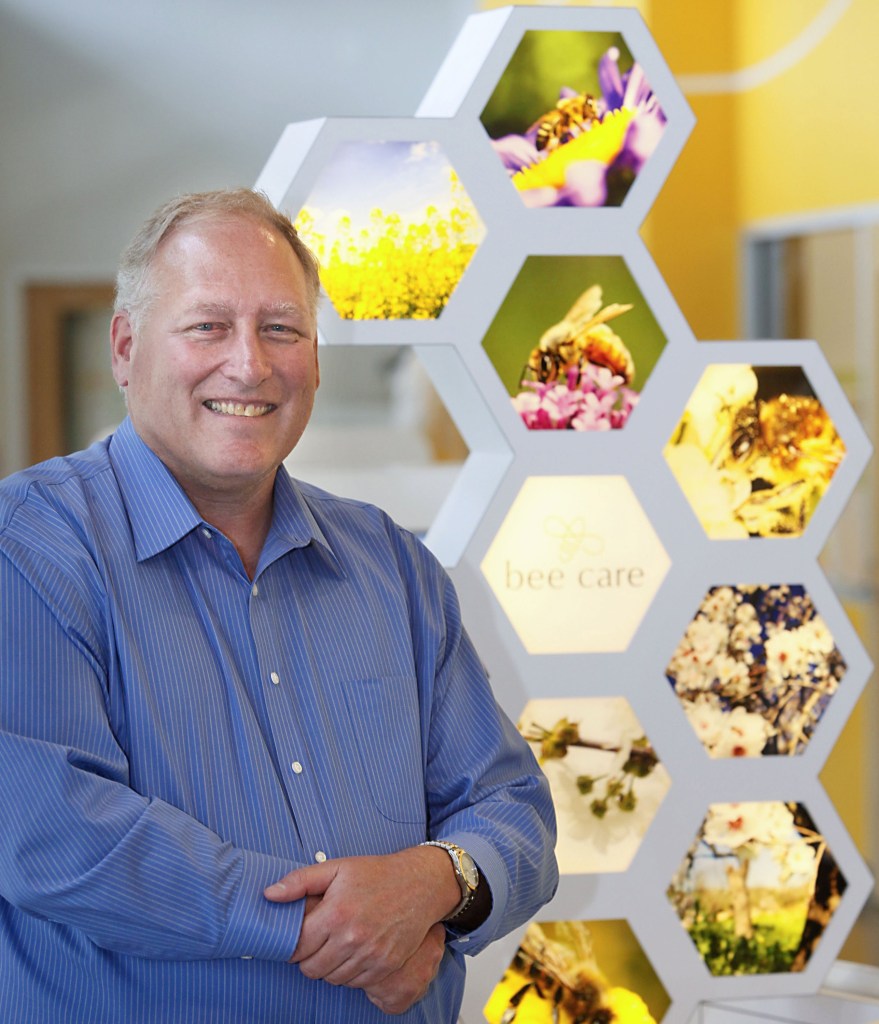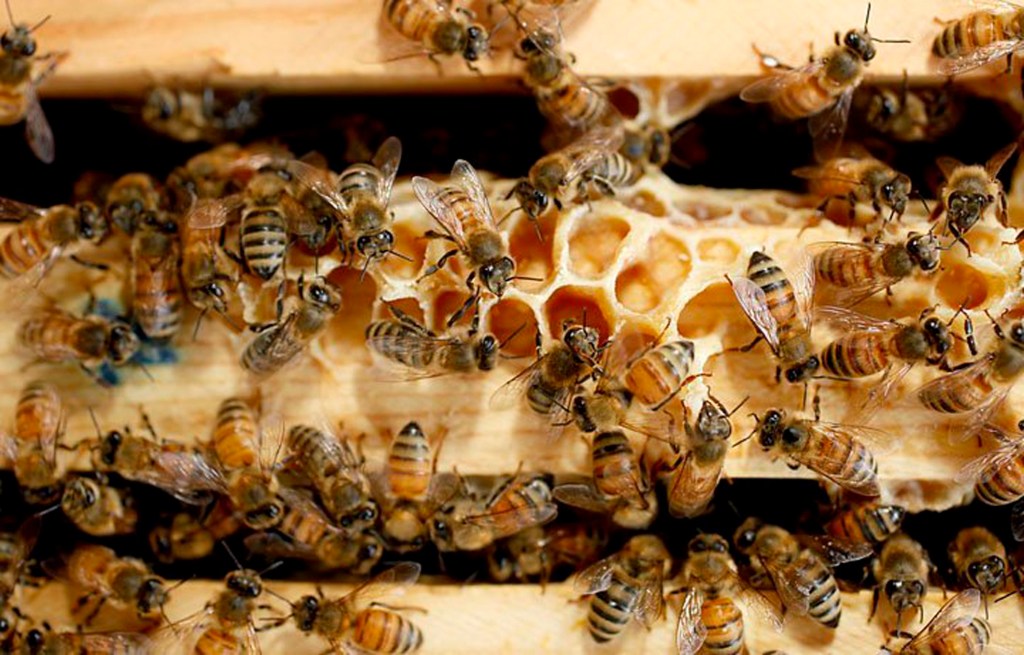RESEARCH TRIANGLE PARK, N.C. — Bayer CropScience’s shiny new $2.4 million North American Bee Care Center demonstrates the company’s commitment to finding ways to improve the health of these vitally important winged insects.
But the very existence of the center is also a symbol of the high stakes at play for Bayer, as well as other agribusinesses, in the debate about insecticides and the alarming rate of bee colony deaths.
Critics say a class of insecticide called neonicotinoids, produced by companies such as Bayer and Syngenta, play a major role in the fragile state of the world’s bee population – which farmers rely on to pollinate many of their crops.
Insecticide makers defend the use of neonicotinoids, commonly called neonics. When used properly, they say, neonics aren’t responsible for killing bee colonies.
They point to studies that show that bee colonies suffer from a cascade of factors, including: pests such as the Varroa mite, which can be deadly to bees; a variety of diseases and fungal infections; extreme weather; and a lack of a diverse food source for bees as development encroaches on their feeding grounds and former pastureland gets planted with crops that aren’t especially nutritious for bees.
“It is equally important to understand that the solution to bee health requires a comprehensive approach,” David Fischer, director of pollinatory safety at Bayer, testified before Congress in April.
The controversy over neonicotinoids – so named because they are chemically similar to nicotine – has boiled over into the policy arena.
In December, the European Union issued a two-year suspension of many uses of three neonics because of concerns about their impact on bee health. A bill calling for a U.S. suspension of neonics has been introduced in Congress. And a coalition of environmental groups and beekeepers has sued the Environmental Protection Agency seeking to suspend the use of two neonics.
The outcome of the debate will affect the future of U.S. farming practices and, one way or another, the bottom line of agribusinesses.
Germany-based Bayer introduced the first neonics in the U.S. in 1994. BASF, another German company, doesn’t manufacture neonics but does include them in two of its professional pest control products used to combat roaches, bed bugs and other insects. Likewise, St. Louis-based Monsanto uses neonics in some of its insecticides and as a seed coating but doesn’t actually produce neonics.
None of these companies breaks out the revenue it derives from neonic products. But neonics are the most widely used insecticides in the world, with estimated worldwide sales of $3.6 billion. In addition to being used as a spray, neonics have been used extensively in the past decade as a coating for seeds.
“One of the advantages of seed treatments is it helps control insects below ground and helps plants get off to a better start,” said Caydee Savinelli, an entomologist for major neonics maker Syngenta.
Each side in the debate over neonics wields scientific studies that buttress its point of view.
“Every year, every month, more and more science publications come out that link neonics to poor bee health,” said Larissa Walker of the Center for Food Safety, an environmental advocacy group.
“There are no studies that link neonicotinoids to widespread bee losses,” said Bayer’s Fischer. “There are studies that evaluate exposures under highly artificial laboratory conditions and report effects, and then speculate what this might mean in the environment.”
Studies that have examined what happens “in the field,” he added, “have concluded there is no scientific evidence that links neonicotinoids to these widespread declines in honeybee health that are being observed.”
Some scientists are on the fence.
“The jury is still out” on how significant a role neonics play in bee health, said Dennis vanEngelsdorp, an entomologist at the University of Maryland.
Still, he worries that farmers and home gardeners are using neonics indiscriminately.
“I think it could be used much more judiciously,” he said.
There’s no doubt that numerous other factors are in play.
“There is … a general consensus that the causes of (bee) colony mortality are multifactorial and interacting,” stated a USDA report issued last year.
In the past eight years, an average of 29.6 percent of honeybee colonies maintained by beekeepers has died each winter, according to annual surveys conducted by the U.S. Department of Agriculture and the Bee Informed Partnership, a group that studies bee health and management.
The latest survey found lower losses of 23.2 percent over the 2013-2014 winter, which is still considered unacceptable. Moreover, losses have dipped before – down to 21.9 percent in 2011-2012 – only to rise again.
Although beekeepers have been able to replace those losses by measures such as splitting a live colony in half and buying a queen bee to repopulate the dead hive, that’s costly and time-consuming. It’s estimated that replacing those lost bees in the past eight years has cost an estimated $2 billion-plus.
The worry is that if such losses continue, it could drive commercial beekeepers out of business, said vanEngelsdorp.
What’s ultimately at stake is the food we put on our dinner table because bees are credited with pollinating one of every three bites of food we eat.
Despite the heated policy debate over neonics, the lowly Varroa mite – which can be deadly to bees – gets a lot of attention from scientists and beekeepers.
“Varroa destructor is a modern honeybee plague,” Jeff Pettis, the lead researcher at USDA’s Bee Research Laboratory, testified before Congress in April. “It has been responsible for the deaths of massive numbers of colonies both within the United States and worldwide.”
“If I had to single out one factor that we could eliminate completely,” Pettis said in an interview, “I’d just take the Varroa mite out of the picture, and then we could deal with these other problems.”
Beekeepers who treat their hives with chemicals that combat the Varroa mite consistently lose significantly fewer bee colonies than those that don’t, said vanEngelsdorp.
Danny Jaynes can relate to that.
Jaynes, the immediate past president of the N.C. State Beekeepers Association, launched his own research project after 43 out of his 50 hives failed to survive the 2012-2013 winter.
“I’m a master beekeeper. I’m not a novice,” Jaynes said. “When I lost all those bees, I was really buffaloed.”
As part of the research project that he began in May 2013, Jaynes set aside six hives and didn’t treat them for the Varroa mite. So far, he has lost five of those six hives.
Jaynes, whose hives are scattered in eight locations across the state, said he has taken care to locate his hives well away from farms that use neonics, so they “are not that great of a threat” to his operation.
Copy the Story LinkSend questions/comments to the editors.





Success. Please wait for the page to reload. If the page does not reload within 5 seconds, please refresh the page.
Enter your email and password to access comments.
Hi, to comment on stories you must . This profile is in addition to your subscription and website login.
Already have a commenting profile? .
Invalid username/password.
Please check your email to confirm and complete your registration.
Only subscribers are eligible to post comments. Please subscribe or login first for digital access. Here’s why.
Use the form below to reset your password. When you've submitted your account email, we will send an email with a reset code.